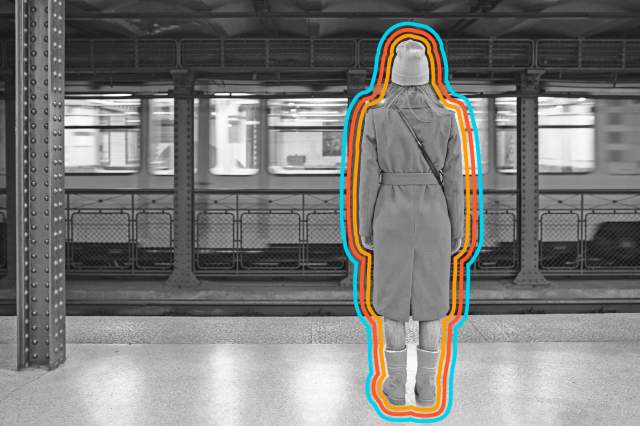
New York City’s First Station Was Abandoned
City Hall seemed like an obvious place for the first New York City subway station — and indeed, 15,000 passengers hopped aboard on opening day on October 27, 1904. But over the next four decades, the 28-station system grew into 472 stations and the stunningly ornate station — with skylights and classic chandeliers — started falling out of use.
Many passengers opted for the nearby Brooklyn Bridge station, which had express service and didn’t require going up and down so many stairs; newer trains also didn’t fit the old City Hall station. The curved platform created gaps between the train and platform, and since the station was so rarely used, the city closed its doors to the public on December 31, 1945. (However, there are occasional tours.)

The First Voice of London’s “Mind the Gap” Had to Be Recast
The world’s oldest underground train system, in London, started using the terms “Mind the Gap” in 1969 because it was a short phrase that could be used both in audio and visual warnings to remind riders to beware of the space between the platform and train door. To ensure the most effective reading of the three words, they hired an actor.
However, “his agent was demanding royalties, which London Underground said it couldn’t afford,” Mark Mason, author of Walk the Lines: The London Underground, Overground told the BBC in 2013. So sound engineer Peter Lodge recorded the phrase and became the first voice of the train. Over the years, the voice actors Tim Bentinck, Phil Sayer, and Oswald Laurence also recorded the iconic announcement.

Pac-Man Is Hidden on Some Stockholm Metro Metal Gratings
While Stockholm is known for its artsy subway stations, riders started noticing familiar figures on the metal grating of the new C30 trains on the metro lines in 2019 — Pac-Man being chased by three ghosts.
“These figures symbolize in a playful way the Swedish gaming industry which has grown so big,” transportation company SL’s spokesperson Elin Lindström told The Local after the debut. And this wasn’t the first nod to the Namco video game icon: A ramp in the Thorildsplan Station is also decorated with the game’s characters.
More Interesting Reads

A Garbage Train Used to Run on Toronto’s Tracks
The Toronto Transit Commission (TTC) used to have a garbage train that collected all the trash along the Yonge-University-Spadina and Bloor-Danforth lines during the late night hours each day. Dubbed the Tokyo Rose, the train was purchased from Japan’s Nippon Sharyo company.
With larger doors so that trash could be quickly tossed inside, the unpainted train looked more like a submarine than a subway car because of its round windows. After 22 years in service, the Tokyo Rose was replaced by old Gloucester subway cars in 1990 and later H1 cars by the end of the decade. Nowadays, garbage collection is outsourced.

Buenos Aires’ Train Cars Ran for Almost 100 Years
Buenos Aires’ Subte was the first subway system in South America when it launched December 1, 1913 — and many of the original train cars that were running along the first 2.1 miles of the tracks were used for just shy of a century.
The wooden interiors were a throwback to times gone by, but unfortunately that also meant many of the parts required to maintain the vehicles were hard to find. In January of 2013, the Belgian-made cars, called La Brugeoise, were retired after 99 years and a month in use and replaced with wagons made in China.
Today the Subte is home to the world’s most crowded transit line, the Urquiza line.

Professional “Pushers” Shove Passengers into Tokyo’s Trains
As the busiest metro in the world, with 3.4 billion riders annually, Tokyo subways have hired oshiya, or pushers — attendants specifically tasked with shoving people into the cars before the doors close.
While they might seem, well, pushy, the hired professionals are dressed to the nines in uniforms, complete with white gloves and dainty hats.

There’s No Eating or Drinking Allowed on Any of China’s 33 Subway Systems
With 33 cities in China having subway lines, the nation enacted countrywide laws on April 1, 2020, to ensure proper etiquette on board. Specifically, eating, drinking, lying down, standing on the seats and blasting music is banned — along with “uncivilized behavior” of any kind. The only exception to the eating and drinking law is young children and those with medical conditions.

Budapest’s Underground Railway Has a Secret Bunker
Hidden 128 feet underground in the center of Budapest between the platforms at Kossuth tér and Deák Ferenc tér is a 37,674-square-foot bunker, commissioned by Mátyás Rákosi, who was the Communist prime minister from 1945 to 1956. In case of a nuclear attack, the space, called F-4 Object, could hold up to 2,200 people and had a passage leading from the Hungarian Parliament so that the government officials could escape using the Keleti train station.
The mega-sized panic room was never actually used, but it was kept on-call through the 1970s — and its existence was finally revealed to the public in the 1990s.

One of the Smallest Subway Systems Is in Israel
Just over a mile long, the Carmelit is one of the world’s smallest subway systems. Located in the Israeli city of Haifa, the train runs up and down Mount Carmel (technically making it an underground funicular), and ascends 899 feet with six stops. It carries 2,000 to 3,000 passengers a day on its eight-minute trip.
Opened in 1959, the diagonal train was shut down from 1986 to 1992 for repairs and then again for four months in 2015 to fix a cable.











